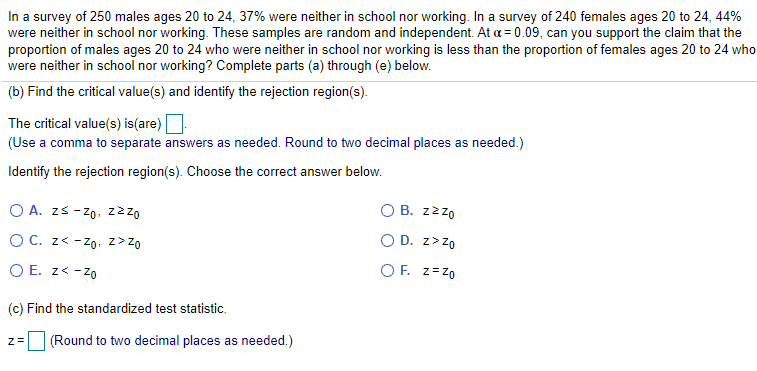In a survey of 250 males ages 20 to 24, 37% were neither in school nor working. In a survey of 240 females ages 20 to 24, 44% were neither in school nor working. These samples are random and independent. At a = 0.09, can you support the claim that the proportion of males ages 20 to 24 who were neither in school nor working is less than the proportion of females ages 20 to 24 whe were neither in school nor working? Complete parts (a) through (e) below. (b) Find the critical value(s) and identify the rejection region(s). The critical value(s) is(are)O (Use a comma to separate answers as needed. Round to two decimal places as needed.) Identify the rejection region(s). Choose the correct answer below. O A. zs -zo. ZZZO O B. zzz0 OC. z< -zo, z>Zo O D. z>zo O E. z< -zo OF. z=z0 (c) Find the standardized test statistic.
In a survey of 250 males ages 20 to 24, 37% were neither in school nor working. In a survey of 240 females ages 20 to 24, 44% were neither in school nor working. These samples are random and independent. At a = 0.09, can you support the claim that the proportion of males ages 20 to 24 who were neither in school nor working is less than the proportion of females ages 20 to 24 whe were neither in school nor working? Complete parts (a) through (e) below. (b) Find the critical value(s) and identify the rejection region(s). The critical value(s) is(are)O (Use a comma to separate answers as needed. Round to two decimal places as needed.) Identify the rejection region(s). Choose the correct answer below. O A. zs -zo. ZZZO O B. zzz0 OC. z< -zo, z>Zo O D. z>zo O E. z< -zo OF. z=z0 (c) Find the standardized test statistic.
Holt Mcdougal Larson Pre-algebra: Student Edition 2012
1st Edition
ISBN:9780547587776
Author:HOLT MCDOUGAL
Publisher:HOLT MCDOUGAL
Chapter11: Data Analysis And Probability
Section: Chapter Questions
Problem 8CR
Related questions
Question

Transcribed Image Text:In a survey of 250 males ages 20 to 24, 37% were neither in school nor working. In a survey of 240 females ages 20 to 24, 44%
were neither in school nor working. These samples are random and independent. At a = 0.09, can you support the claim that the
proportion of males ages 20 to 24 who were neither in school nor working is less than the proportion of females ages 20 to 24 who
were neither in school nor working? Complete parts (a) through (e) below.
(b) Find the critical value(s) and identify the rejection region(s).
The critical value(s) is(are)
(Use a comma to separate answers as needed. Round to two decimal places as needed.)
Identify the rejection region(s). Choose the correct answer below.
O A. zs - zo. z2z0
O B. zzzo
OC. z< - Zo. z> Zo
O D. z>Z0
O E. z< -zo
O F. z=z0
(c) Find the standardized test statistic.
|(Round to two decimal places as needed.)
Z=

Transcribed Image Text:In a survey of 250 males ages 20 to 24, 37% were neither in school nor working. In a survey of 240 females ages 20 to 24, 44% were neither in school nor working. These samples are random and independent. At a = 0.09, can you
support the claim that the proportion of males ages 20 to 24 who were neither in school nor working is less than the proportion of females ages 20 to 24 who were neither in school nor working? Complete parts (a) through (e) below.
(a) Identify the claim and state Ho and Ha.
The claim is "the proportion of males ages 20 to 24 who were neither in school nor working is
v the proportion of females ages 20 to 24 who were neither in school nor working."
Let p, and p2 be the two population proportions for males and females, respectively. State Ho and Ha.
Choose the correct answer below.
O A. Ho: P1> P2
O C. Họ: P1 2 P2
O B. Ho: P1 =P2
Hạ: P1 P2
Ha: P1 sP2
Hạ: P1 <P2
O D. Ho: P1 < P2
H3: P12 P2
O E. Ho: P1 sp2
H3: P1 > P2
O F. Ho: P1 # P2
Ha: P1 = P2
(b) Find the critical value(s) and identify the rejection region(s).
The critical value(s) is(are)
(Use a comma to separate answers as needed. Round to two decimal places as needed.)
Identify the rejection region(s). Choose the correct answer below.
Expert Solution
This question has been solved!
Explore an expertly crafted, step-by-step solution for a thorough understanding of key concepts.
This is a popular solution!
Trending now
This is a popular solution!
Step by step
Solved in 2 steps

Knowledge Booster
Learn more about
Need a deep-dive on the concept behind this application? Look no further. Learn more about this topic, statistics and related others by exploring similar questions and additional content below.Recommended textbooks for you

Holt Mcdougal Larson Pre-algebra: Student Edition…
Algebra
ISBN:
9780547587776
Author:
HOLT MCDOUGAL
Publisher:
HOLT MCDOUGAL

Holt Mcdougal Larson Pre-algebra: Student Edition…
Algebra
ISBN:
9780547587776
Author:
HOLT MCDOUGAL
Publisher:
HOLT MCDOUGAL